Yankees and the AL East: 25 years as baseball’s best division

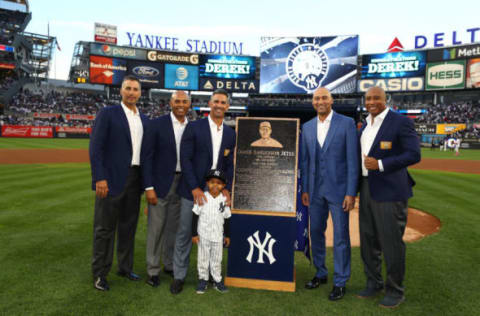
Yankees and the AL East have spent the last quarter century as basball’s best division. And the boys from the Bronx have been the best of the bunch.
The 2017 Yankees have an excellent chance of making the playoffs, and doing damage if they do, while the Red Sox are one of the post season favorites. There is even a chance the Tampa Bay Rays will win the second wild card spot. That would put three teams from this one division in the playoffs.
That’s nothing new for baseball’s best division: The American League Beast. This division has earned that moniker for the years 1992-2016 by consistently winning the most games during the regular season, and the most championships in the post.
Baseball is All About the Numbers
The AL East has placed 42 teams in the AL playoffs during that run, out of a total of 101 opportunities. Next closest is the NL East, which has had 35 qualifiers in that league’s 101 opportunities. That’s a drop from 42 percent to 34.
And the success rate once in the playoffs paints a more powerful picture. The Yankees and the AL East have been responsible for 25 of the 48 teams that have made the ALCS, more than half the combatants. Once again the NL East is second with 17 in their NLCS.
Staying in second to the Beast, the NL East has sent eleven teams to the previous 24 WS, while the AL Eastern Division has sent 13. Still, not a great disparity.
No, it is the winning of championships that shows the chasm between the AL East and all other divisions: Their teams have won ten of the previous 24 World Series championships. As expected, the next closest is the NL East. And how many have they won, this second best division? Four.
Winning is Everything
Adding to all of this is that ten of the thirteen times an AL East team went to the WS, it won. But the NL East teams could only win four out of their eleven opportunities.
It also means the AL East has won 42 percent of all the MLB championships since 1992, while the next best showing is 16 percent. That’s domination of an entire sport.
And the Yankees have been the best of the lot. That’s all a bit dry, but it sets us up for more interesting reading (or at least that’s the hope).
One more note before moving on, though: this article is about winning consistently over the entire time span. Although the NL East is deservedly second on this list, it bears pointing out that the vast majority of its success is due to the Atlanta Braves.
And their glory days ended several years ago, as did most of the success of this division.
That division has sent only thirteen teams to the playoffs in the last decade (2007-2016), out of a possible 45, and made the WS just three times. The last team from this division to win it all was the Phillies, way back in 2008. And the next year that same team was beaten by the Yankees.
That takes care of the overview. But before we can get on to looking at how each AL Beast team has contributed to the greater good, there are some methodology matters that need to be explained.
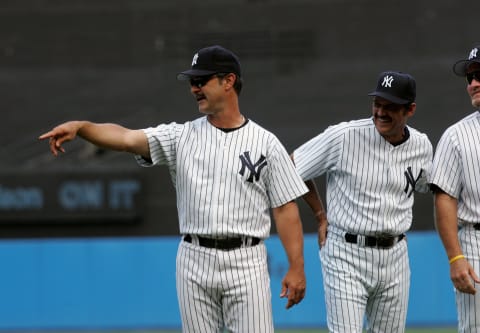
At Least in Some Ways
Baseball has changed a lot over the last 25 years; I bet the same could be said of you, dear reader.
First, there were only four divisions in 1992 when our examination begins, only an east and west in each league. There were 26 teams, but only four made the playoffs.
And the postseason was a total of three series: an LCS for each league and the World Series. Today there are thirty teams, six divisions, and four rounds of playoffs. Adding to the difficulty, some teams have changed cities, names, divisions, and even leagues in that time.
Resolution
All of this provides some challenges in making comparisons, and here’s how they were resolved. The league each team is in now was given credit for all that team’s wins over the last quarter century. That means, for the purposes of this analysis, the AL East has always been New York, Toronto, Boston, Baltimore, and Tampa.
That works out well for the teams that have contributed most—NY, Beantown, Toronto—were in this division even way back in 1992. So, I also assigned all of the Braves wins to the NL East because that’s where they are now; Atlanta, Georgia was considered part of the West back in ’92.
And some of the numbers are pointless. Each of the four divisions sent one and only one team to the playoffs in 1992 and ’93, so citing the entrants from those two years is redundant. They are included due to the Blue Jays performances in the World Series, but would by themselves be meaningless.
My guess is some of you have already questioned my math skills. I have repeatedly mentioned 24 titles in the last 25 years. That’s because there was no World Series in 1994, a sad and dreary end to a contentious season.
The More Things Change…
But even then, the pattern holds up. The Yankees were the best team in the AL (70-43), while the Montreal Expos—who were in the NL East and became the Washington Nationals—were the best team in baseball (74-40). Below is a complete list of playoff success by division and World Series success by team.
After that, it’s finally time to look at how each team in the mighty AL Beast has contributed to the overall success over the last quarter century.
World Series titles by division: AL East 10; Central 2; West 1; NL East 4; West 4; and, Central 3.
WS wins by team: Yankees 5; SF Giants 3; Red Sox 3; Blue Jays 2; Marlins 2; Cardinals 2; and, one each for the Braves, Phillies, White Sox, Cubbies, Angels, Royals, and Diamondbacks.
And now, here we go.
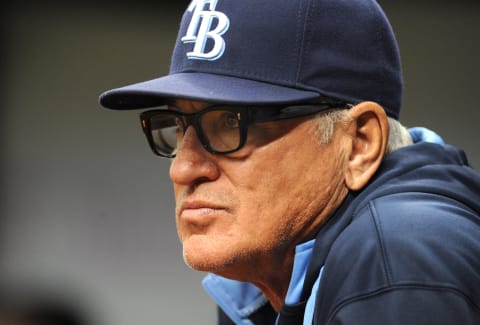
Neither the Baltimore Orioles nor the Tampa Bay Rays (nee Devil Rays) won titles in this span of time. But each found at least some significant success.
The Rays
The team from Tampa, devilish or not, has been in existence since only the ’98 season. They have never won a World Series but have had recent, if fading, success.
Their most successful run by far came back in 2008. Under manager extraordinaire Joe Maddon, the team won the AL East and made it all the way to the World Series, beating Boston in the LCS. This was one of five times the ALCS featured only Eastern Division opponents since 1992.
They lost to the Phillies, who ironically out-pitched Tampa Bay.
That year provided one of the few important preseason games ever played. Maddon was trying to instill a competitive edge into this listless franchise. One of the first players to receive that message was reserve second baseman Elliot Johnson, a footnote to their regular season run.
But that foot seemed to give the entire team a kick in the rear when he barreled over C Francisco Cervelli en route to scoring on March eighth of that year; Cervelli was out for the season. Yankees and Yankees fans didn’t like it, but the play was later repeatedly cited by Maddon and the team as the catalyst for the entire year.
Tampa would make the playoffs three more times through 2013 but lose in the LDS each time.
Baltimore has climbed higher more often in the last 25 years than Tampa, but has not been able to make any WS appearances in that time.

The Orioles
Baltimore is an ancient baseball town and the Orioles have a rich and proud history. The team started in 1901 and has called both Milwaukee (the Brewers) and St. Louis (the Browns) home.
But since 1954 the team has resided in Baltimore, where it chose it’s name both from the state Bird of Maryland—the Oriole, as you might have guessed—and because that was a traditional team name for local clubs starting back in the 1800’s.
I write all of that because the Birds deserve the respect. They have appeared in six World Series as the Orioles, winning half, the last one in 1983. That might not seem like much, but there are a lot of teams that would take three WS since 1966, including the Cubs, Indians, White Sox, Braves…the list could really go on and on.
At Least they’ve Contributed to the Greater Good
And even in the last quarter century, the O’s have had two decent runs. They made the ALCS in ’96 and ’97, losing to the Yankees in the former year. 1998 saw them start a rebuild that would last until 2012, when they would announce their progress by winning the Wild Card game but losing the ALDS to the Yankees, once again.
However, they returned in 2014 to win the division (96-66) and become the AL East’s only qualifier for postseason play. Their loss to the Royals in the ALCS, however, would be their most recent high water mark. They missed the playoffs in 2015 and were eliminated by the Blue Jays in last year’s Wild Card game.
Three LCS appearances and no World Series wins in 25 years isn’t much but it still shows more success than some teams, such as the Athletics and Astros, and is better than Milwaukee and San Diego combined.
And now on to the World Series winners.
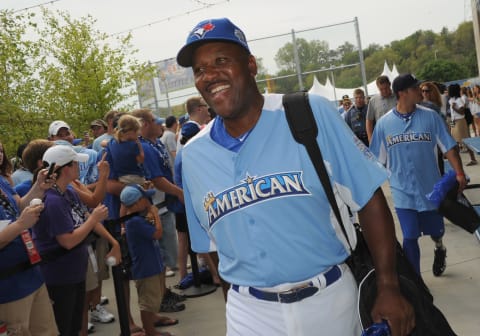
Toronto Blue Jays
The Blue Jays recently completed a run, representing the AL in the last two LC series. Based on their recent record, that appears to be it for a while.
Still, as they faced two different teams in those successive years (Royals in 2015, Indians in 2016), it is reasonable to argue they have been the best team in the American League over the last two seasons.
But it is their earlier run that was not only far more significant but also started the AL East’s ownership of the Commissioner’s Trophy.
In 1992, The Jays won the first of their back-to-back World Series titles. They were the first team in baseball to accomplish this since the ’70’s, when the AL East’s Yankees did it.
In fact, since the AL was split into East and West in 1969, five teams have repeated as champions, some more than once: Athletics (72-74), Reds (75-76), Yankees (77-78), Blue Jays (92-93), and the Yankees, once again (98-2000).
It’s been done five times in history and the AL East has accounted for three of them, two in the last quarter century. To appreciate what the Jays did when they did it, it is necessary to take a quick glance at other great teams from the previous seasons that were not able to equal the Jays.
Notice there are No Yankees Teams
Even though the Eighties produced several truly great clubs, only one was able to win two titles, and none won in two straight years.
In 1984, the Tigers won 104 games, the most since the Big Red Machine put up 108 W’s in 1975. They looked every bit the super team, yet that was their only playoff appearance. The Mets looked even better when they won 108 games in 1986.
But they barely won the WS because of Bill Buckner’s bad defense, only qualified for the playoffs one more time, and did not appear in the Fall Classic again until the year 2000.
Even Oakland, who looked like they might have the modern Murderer’s Row and did appear in three straight World Series (88-90), only managed one title in that time.
That’s what made what Joe Carter and the Jays did so pleasantly surprising and significant.
1992: It Begins
In 1992, Toronto beat Philly in six games. Carter led his team by hitting .273/.346/.636 with a team high two home runs. Future Yankees David Cone was on that team, as was former Yankee Dave Winfield.
It was Winfield who got the game winning hit, but Carter, along with fellow Jays infielders, saved the game: he gave pitcher Mike Timlin timely advice that led to the final out.
Carter, however, had a more direct hand in leading the Jays to their repeat victory in ’93. Once again, it took the Jays six games to win, although they were able to do so without extra innings. Carter hit well once again, although Roberto Alomar and Tony Fernandez had better series’.
But great players play great in big situations and Carter was certainly that.
In game six, with one out in the bottom of the ninth and his team down 5-6, Carter came to the plate. On base were Paul Molitor and former Yankees player Rickey Henderson. On a 2-2 count, Wild Thing Mitch Williams uncorked a pitch that Carter blasted into the seats for an 8-5 game–and series–victory.
His home run propelled him to all-time highlight status and the Jays to the second of their two total championships, the first of ten the East would collect through 2016.
Only three other teams have won more than two titles since 1993, and two of them play in the AL East.
And that brings us to the New York Yankees.

New Beginnings
The Yankees have been the most successful team in baseball over the last 25 years, and it is they who have contributed the most to the AL East’s status.
The New York Yankees have qualified for 18 of the 24 postseasons in the last 25 years, including a 13-year unbroken stretch (1995-2007). They won the American League Pennant seven times, almost one third, with six of those coming in an overwhelming eight-year stretch (1996-2003).
And they won five World Series titles, including three in a row from 1998-2000, and four in five seasons (1996).
Think about that. Twenty-four teams have won five or fewer titles in their history; twenty-two teams have never won more than four, and eight teams have never won even a single World Series. Even with their recent success, the Red Sox have won only eight titles all-time, just three in the last 99 years.
Wait for it…
The Yankees, meanwhile, won five in the last 25 years.
Their run did so much more than that, though, for both the Yankees and the division’s reputation. When the Yankees won three titles in a row, they did something that had not been done since the Oakland Athletics (72-74), who were led by future Yankees self-aware star Reggie Jackson.
The only other teams to accomplish the feat in the history of baseball are all Yankees teams, the last coming in the early Fifties.
And when they won four in five years, they equaled what only other Yankees teams had ever done: Ever. Even though I think of the recent SF Giants run as a dynastic one, they never did that.
Now it’s time to go back to 1996, and the start of this historic epoch.
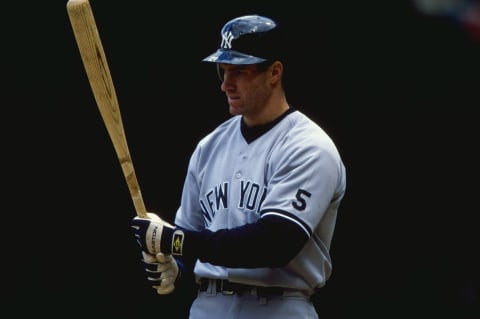
A Yankees Rebirth
It’s 1996. The Yankees haven’t come close to winning a World Series since 1981, when they lost to the Dodgers; that might happen again soon. Their last title came two decades earlier in 1978. It was the longest title drought in Yankees history.
But under the careful eye of Gene “Stick” Michael, the Yankees did something the Boss thought not possible. Stick was growing a team of young players, instead of trading them for current stars. That plan had failed for more than a decade, with Yankees youngsters becoming big time players on other teams.
I lived in the northwest in the mid-nineties. Yankees fans have no idea what they missed out on when George Steinbrenner traded away Jay “Bone” Buhner. And he was just one. Instead, the Yankees signed players such as Danny Tartabull from the Royals. There’s a reason you have heard of Buhner but not Danny.
But now a new world order was rising in Yankees universe, and their stars would soon bring death to the rest of baseball.
The Previous Group of Baby Yankees
The change was led by the Yankees highest draft pick to date, Derek Jeter; 1996 was his first full year. Mariano Rivera had washed out as a starter but won the set-up role; John Wetteland from the Rangers was the closer.
That year still stands as the best Mariano ever had, or any reliever for that matter and the tandem shut down the last three innings of a game better than any bullpen before or since. The rotation, meanwhile, was augmented by Andy Pettitte, who would anchor the staff for years to come.
Jorge Posada was still developing, so Joe Girardi did most of the catching. Bernie Williams was the old man of the bunch; he was 27 that year. Meanwhile, Jeets was a baseball puppy at 22 and Andy was all of 24. That’s why they were still around in 2009 when Bernie was already playing Bach in Bridgeport.
Primetime
Added to this were two players already in their primes. The Bamtino, Tino Martinez (28), had just come over from Seattle, joining Paul O’Neill. The Warrior was not only the oldest player of this historic group, but also the only one with World Series experience. That would soon change.
Paul was on the Reds 1990 WS winning team, but the two sides were unhappy. In what can only be called a steal, Paul was traded to the Yankees before the ’93 season for Roberto Kelly. Again, there’s a reason you know O’Neill but not Kelly.
The trade paid dividends when The Warrior won the batting title in 1994 (.359), and his tutelage helped an entire new generation of Yankees hitters. He drove the Yankees with his fire and helped form the top of an order that would win four titles in five years.
When he played his last inning in the field at home, in the 2001 World Series, the fans chanted his name for the duration. No player ever deserved it more. He really was The Warrior.
But that 1996 team was not objectively great and clearly destined for greatness. They had a lot of great role players, like the Royals winning in 2015 more because of their bullpen than their starters. If the Yankees wanted to overcome their years-long malaise, they were going to have to earn it.
The World Series did not start out well, but, that’s how it goes when you have years of futility to overcome. Fortunately, their new manager was super cool.
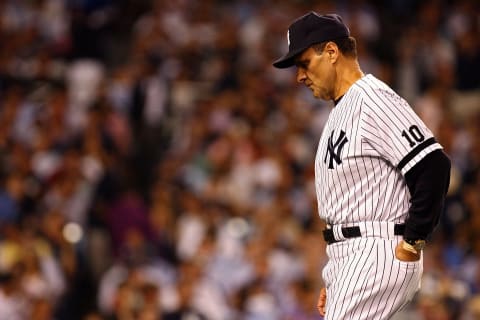
Feeling the Vibe
The Yankees started this series at home, where they promptly lost both games to the Braves. Atlanta was the reigning champion and hoped to be on their way to team of the decade. Were that true, I might be writing about their division as the most dominant.
But that was not to be. For George Steinbrenner had hired a new manager that year, Joe Torre. Joe had been an excellent player and knew the game well, but he had never won it all. He hadn’t even been to the WS before, without buying a ticket.
However, Mr. Torre proved himself the master of the moment. The Boss called him into his office after the first home loss and demanded answers. Joe’s response was both confirmed by more than one source and became part of World Series lore forever.
Joe knew his team; he could feel the vibe in the clubhouse. So he told the most impatient, demanding owner in sports that he did not think his team would win that night. They were not ready and instead would go down 2-0 in the World Series.
That was okay with Joe; didn’t bother him a bit.
And it Worked!
The Yankees were tight, he would go on to say but would relax in Joe’s old stomping grounds: Atlanta. Torre predicted, right there in George’s office after game one, that the Yankees would sweep the Braves on the road and finish them off at home, in six.
And that’s exactly what they did. When the last out of game six was finally recorded in Yankees foul territory, an exuberance followed from both players and fans that I doubt any of the other championship years could equal.
Although they didn’t know it at the time, the team did more than winning a World Series title; it had just launched a dynasty.
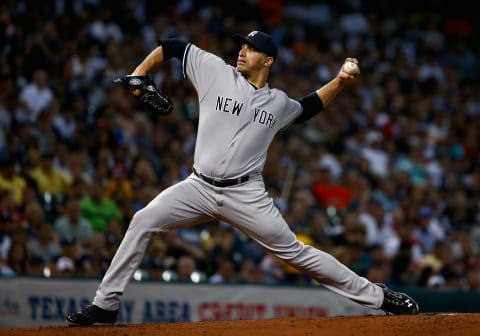
The 1998 Yankees: One for the Ages
But that would have to wait a year, as the Yanks were bounced from the playoffs in ’97 by the Indians. As Brian Cashman recently alluded to, Yankees think regarding championshipS, not championship.
So, before the 1998 season, Micheals and The Boss added what they hoped would be the missing pieces for a better, deeper team; turns out they were right.
Four-time All-Star and now admitted PED user Chuck Knoblauch came over from the Twins, while no-time All-Star Scott Brosius moved all the way from Oakland. With Jorge Posada the everyday catcher, the Yankees offensive engine was now finely tuned.
On the pitching side, 1998 was the first year for Cuban exile Orlando Hernandez. El Duque and his 3.13 ERA, and big game attitude, replaced Kenny Rogers in the rotation (5.65 ERA in 1997). Today Rogers is more well known for walking in big runs rather than coming through in the clutch.
Do the Math
When added to Pettitte, David Cone, and David Wells, the Yankees had four guys who could go out and compete against any pitcher in the league. That ’98 team was a steamroller, winning 114 games in the regular season and going 11-2 in the playoffs.
They swept the awe-struck San Diego Padres and manager Bruce Bochy, who has since seen better days. The team was indeed a leviathan, winning a total of 125 games, still a record. And it stands as the best team in the modern era.
There are reasons for achievements like that; here are two of the biggest.
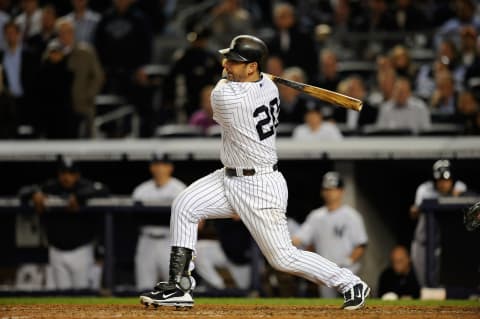
Maybe O’Neill just doesn’t like Water Jugs
First was their attitude. The Yankees younglings might have been surprised to win in ’96, but now they expected to. With Paul O’Neill destroying water jugs and endlessly practicing his swing in the outfield, Derek Jeter never, ever giving away an at-bat, and Posada getting in the face of anyone who gave less than everything at all times, this team was loaded with leaders.
Add to that the anger of losing in 1997. The Yanks felt they were the better team. And when they came back for the ’98 season, they had a chip on their collective shoulder that never really fell off.
But the other significant component was Yankees mystique. Several players had all of their best years once they donned the pinstripes. Scott Brosius had never been trusted with 500 AB’s or achieved any notes of distinction.
Brosius Batted Ninth in 1998
In ’98 however, he got 530 AB’s, hit an even .300, and was named to his only All-Star game. The season culminated with his winning the World Series MVP. Even his defensive play improved as he won his only Gold Glove the following year, again helping the Yankees to the title.
Paul O’Neill never once hit above .276 in Cincinnati. The team wanted him to be their middle of the order power hitter. The Yankees told him just to be himself, and he rewarded them with six straight seasons hitting well above .300. And his home run totals went up, as well.
Had Paul played his entire career with the Yankees, he would have waltzed into the Hall of Fame.
Joe Torre and the Yankees also got the best of Tino. His home run totals with the Yanks are Hall worthy; it’s just that the rest of his career did not produce the same results. It was those factors, and a thousand, thousand little ones, that enabled the Yankees to go on a historic run.
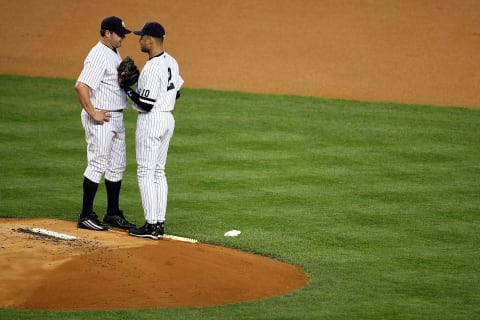
Two with One Page
The ’99 series was a supposed to be a competition with the Braves for Team of the Decade. But the Yankees had replaced Wells with Rocket Clemens before the season, and the offensive engine continued to hum.
They beat the Red Sox in the ALCS, and then swept the1999 World Series.
In the end, the series became a coronation for the Yankees as the Team of the Year, Decade, and Century. More importantly, it ensured their placement in this article. So, there’s that.
Continuing their run in 2000, the team played worse, but the results stayed the same. They went on out to meet the Mets in the first New York Subway Series since the Dodgers played in Brooklyn. The outcome was never in doubt, and the Yankees won in five.
Derek Jeter was not yet Captain, but he was already the leader of the team. He proved it in 2000 when he became the first and still the only player to win both the All-Star and World Series MVP awards in the same season.
His home run to lead off game four, after the Mets had won the previous game, was as big as any hit that season.
A Bridge Too Far
When the 2000 series was over, so was the Yankees run of championships, at least until 2009. They would go on to appear in two of the next three Fall Classics but would lose them both.
The team would rise again in 2009 for one last hurrah. But before that, the Red Sox would take the mantle as the best team in the division and ensure the Beast would remain the best in baseball: The Boys from Beantown would win three World Series titles from 2004 to 2013.
However, before they could do any of that, they had to take down the Yankees. The two teams faced off in three memorable ALCS in six years, the Yankees winning two. Those meetings not only showed the passing of the torch and what it means to win the AL East, but also are a microcosm of the real import of this division.
That story began in 1999.
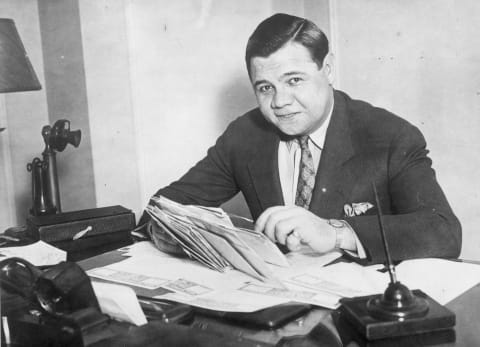
New York Yankees versus Boston Red Sox, Vol. I
Before the 21 century, Boston had not won a World Series title since 1918. Up till that time, they were a juggernaut, winning five titles in fifteen years, including two of the last three. But when then-owner Harry Frazee sold Babe Ruth—and his baseball soul—for a great big wad of sweaty cash, he angered the fans…and the baseball gods.
They decreed that Boston would have to beat the Yankees in head-to-head competition if they were ever to win another title. That would not happen until 2004.
It was they who helped Bucky Dent hit the decisive home run when the two teams met in a one game playoff all the way back in 1978; Reggie didn’t need any help and he certainly wouldn’t acknowledge it if he had gotten any. And those same gods punished Boston for trying to win it all without going through the Bronx in 1986. Bill Buckner was no accident.
Back to the Past
That brings us to 1999. This was the first year ever that the Yankees and Red Sox met in the ALCS. The two teams would go on to meet three times in the LCS over the next five years, including back-to-back meetings in ’03 and ’04.
New York was not only the reigning champion but also had won two of the three previous titles. And they had just completed the best year in modern baseball history.
Boston, meanwhile, fielded good teams every decade but never put a full, championship team together. This was their first real chance since 1986.
A broad statistical analysis alone would be confusing. The Red Sox out hit the Yankees: .293/.350/.467 as compared to .239/.313/.409. And Boston’s ERA was slightly better, .368 to .380.
Pedro Martinez was the best pitcher on either team and finished the series with a 0.00 ERA. How, then, did the Yankees win this series 4-1? I said it would be confusing.
Well, Susan, That’s Baseball
The answer is that baseball has always been baseball. First, the Yankees bullpen was the superior of the two. I doubt Rod Beck, Boston’s closer, can walk foot in the city, let alone Yawkey Way. He pitched in two games for a grand total of two-thirds of an inning and finished the series, and the Red Sox, with a 27.00 ERA.
Second, their errors were many and costly. They committed ten in the five game series, twice as many as the Yankees. Nomar Garciaparra committed four errors by himself, although it seems as if the two by Jose “Boo Boo” Offerman were perhaps more costly. Be that as it may, the Sox threw this series away.
Jeff Beck Would have Been a Better Choice
Finally, the Yankees showed once again it is not how much you hit, but how timely that hitting is. The Boys from the Bronx simply got the hits when they needed them, a lesson the current team still needs to learn. Bernie Williams, baby, burned a solo shot in the bottom of the tenth inning of game one and walked off in style.
And although the Yankees were already ahead 5-2 when Ricky Ledee ripped a grand slam in game four, it was still a big hit. It gave the Yanks immense adrenaline that they carried over into the next day, scoring two in the top of the first.
But it also destroyed Rod Beck for the rest of the series, as both Ledee and Williams had gotten their home run hits against him.
It was a series that resonated for the Yankees, Red Sox, and all of baseball. The Yankees would go on to win the World Series that year and the next, and appear in two of the next three after that. The Sox would spend the next three years getting better pitching, more powerful hitters, and a desire for revenge.
They got their next chance in 2003.
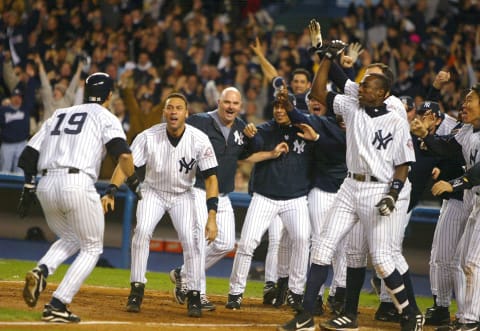
Yankees/Red Sox Vol. II
The teams had both made changes by 2003, the Red Sox adding both David Ortiz and Manny Ramirez. In fact, when Manny Ramirez signed with the Sox before the 2001 season, he famously quipped he was doing so because “I’m just tired of seeing New York always win.”
The Yankees had gone through significant changes of their own and, by the time the two teams met again in the 2003 ALCS, both were vastly different. And both had reason to be confident going into that series, although the Yankees seemed a bit worse than the ’99 version, while the Sox were just entering their prime.
The Yankees won again, and in the process helped create a classic. This series featured brawls, both the police and paramedics, wild momentum swings, and one of the greatest comebacks in postseason history. And it featured baseball played at a high level, with both teams leaving everything out on the field.
When it was over, one team stood victorious, while the other could barely stand.
Truth is Stranger Than Fiction
The first two games saw the teams exchange comfortable wins, taking small early leads that were never relinquished. Game three, however, provided spectacle and the greatest coming attractions since God spoke to Noah.
The game featured Boston’s former ace, Roger Clemens, and its current one, Pedro Martinez. By the time they met, Clemens had won six Cy Young awards, although PED use has been strongly suggested.
Pedro had already won all three he would ever win, his most recent coming in 2000; Clemens won it in 2001.
But this is a short synopsis, and those citations are far from telling the whole story. By October 2003, Martinez had already established himself as perhaps the best right handed pitcher in the modern era.
Clemens had established that he was struggling with some mysterious rage issues. The image of him picking up a splintered bat and throwing it at Mets catcher and bat splintered Mike Piazza in the 2000 World Series is as hilarious as it is indelible.

Using Your Head
Martinez and Clemens faced off in Game Three, and it turned into a rare and unique classic. When the pitchers tried to throw strikes, they did okay, with the Yankees winning 4-3. But when the pitchers tried to send messages, they were far more successful.
It all started in the fourth inning, although it might be more accurate to say it started the day Ruth was sold. A frustrated Pedro, who had given up four runs, threw at Karim Garcia’s head. Garcia had no problems expressing himself, either: First he yelled, and then he slid overly hard into second baseman Todd Walker; the benches cleared.
Thinking his message was still a bit vague, Martinez decided to be more opaque. Responding to the threats of Jorge Posada, who was yelling from the dugout, Pedro pointed at his own head in a way that some, like Dan O’Shaugnessy of the Boston Globe, felt was an indication of Pedro’s willingness to throw at Georgie’s head if the opportunity should present itself.
Nonetheless, order was restored; that lasted less than an inning. In the bottom of the frame, Manny Ramirez overreacted to a pitch that even CBS referred to as,
…slightly inside at most.
Bat in hand, he headed for the mound and a more than willing Roger Clemens. Benches cleared again and this time fights broke out. But the most bizarre incident happened when 72-year old Yankees bench Coach, and former Red Sox manager, Don Zimmer decided to get involved.
Some Decisions are Better than Others
Zim charged at 30-year old Pedro Martinez, a world class athlete in his prime. Running like an old, drunk, hippopotamus, Zimmer listed head first towards Martinez. Taking a Daoist approach, Pedro took what was offered him. He grabbed Zim’s head with both hands and twirled him to the ground.
For longtime readers, and my editors, I feel I must say at this point: I am not making this up.
It got a lot weirder than that later, with Karim seemingly getting into a brawl with a Red Sox employee, but you can read about that for yourself. When the dust settled, fines were issued, the police were involved, Zimmer left the stadium on a stretcher, and the Yankees won the game.
But not the series; not yet. Neither team could take control of the series, and it was tied after six games. That set baseball fans everywhere up for a treat.
First, it meant an ALCS game seven. And this one between ancient enemies, the Yanks and Red Sox. It also meant a rematch of game three, again featuring two of the best pitchers in the game. All of that played out with the events of game three still extremely fresh in the everyone’s mind.
It was an incredibly significant game for the Sox, Yankees, and AL East as a whole.

A Long Day’s Journey into Immortality
That game, game seven, not only lived up to the expectations, it surpassed them. I remember that night. I was going to college deep in the heart of New Hampshire; Sox fans were ubiquitous. In every room, TV’s beamed lights onto nervous but excited faces. By the seventh inning stretch, those same faces were beaming right back.
The Sox were up 4-1, and Pedro was cruising. And this time, the Sox had plenty of quality arms if and when Pedro got in trouble. When the fans sang about the good times never having felt so good, even during this away game, they meant the exact moment they were in.
I was having a hard time. It appears that I had done a lot of taunting during the previous six game stretch and tomorrows menu seemed certain to read: Fresh Crow, no waiting. In an attempt to change the Yankees luck in the fifth inning, I walked across the Green to the common room in the main hall, as if a different TV would tell a different story.
Taking it Personally
It only made things worse. Happy, excited Sox fans were trying to control their emotions lest they offend the gods again. But their quiet, confident giddiness was more annoying than any outright cock-surety.
By the time I returned to my room for the certain denouement, I felt as if I had heard all of New England take part in the largest Neil Diamond karaoke performance of all time.
That all changed in the bottom of the eighth. A lot of things changed in the bottom of the eighth. That’s when that much-anticipated trouble came for Pedro, and that of the long-suffering Sox fans was hard behind.
Boston began the bottom of the inning with a 5-2 lead, but that lead was threatened after Pedro retired the first batter.
First, Jeter doubled, followed by a single from Bernie; that scored Derek. The game was now 5-3. Still-excited voices hoped that Red Sox manager, Grady Little, would call upon a reliever. Little did go to the mound, but not the bullpen.
That move was controversial but not unprecedented. Pedro was his best pitcher, the team still had a two run lead, and there was only one man on. But when Martinez promptly gave up a grounds rule double to Matsui, putting Yankees on second and third with one out, it seemed to all observers that it was time to pull Pedro.
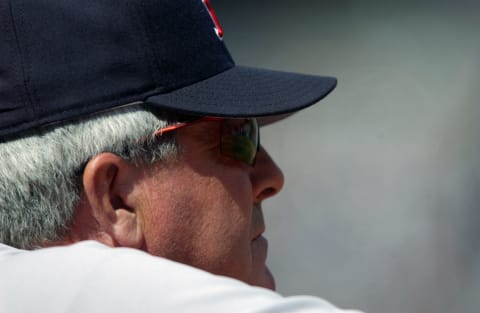
What was he Thinking
All those disembodied voices emanating from crowded rooms were now loud and agitated, and they wanted Pedro out of the game. Even the TV announcers openly questioned the wisdom of leaving Martinez in to face his message-mate from game three, Jorge Posada.
Even I thought Little should pull his starter, and I wanted the Yankees to win.
But, at that moment, Little decided to leave Pedro in the game. It’s the type of decision he made many times throughout the season, only this time it cost him a career.
With every voice, I could hear—from the muffled, anxious voices seeping out from doors left ajar, to the shouted slurs of imbibing fans, to the calm, quiet confusion of the TV announcers—everyone watching that game could tell it was time to remove Pedro Martinez.
Only the baseball voice emanating from Grady Little’s gut said leaving in Pedro was a good idea. Grady went with his gut and gave all of New England indigestion.
The Other Good Book
What happened next seemed to Sox fans to come directly from the Bambino Curse playbook. Posada hit a double. It sent Bernie and Matsui-san home and left Jorge on second, arms raised and screaming with passion. Those two runs tied the score and sealed Little’s fate.
All the energy and excitement around me dissipated before Posada’s ball landed. And then they knew, as their fathers and grandfathers knew before them, that the curse was to live on for at least one more year.
With the game now tied and the Yankees at home, then-manager “Saint” Joe Torre brought in closer Mariano “Toyota” Rivera. He proceeded to throw three innings of two-hit ball.
In that pressure cooker, for a man who now rarely threw two innings and never three, in a career filled with great performances in the biggest moments, this was Mariano’s single best outing. He would later say he was ready to go back out for the twelfth.
The Yankees offense did even worse, getting not even a hit, as Little kept changing his Sox. He went from Alan Embree to Mike Timlin (yes, the same Timlin from those early 90’s WS winning Blue Jays teams) to knuckleball starter Tim Wakefield.
It was game seven, and everyone was available. Boomer, starter David Wells, would have been next for the Yankees.
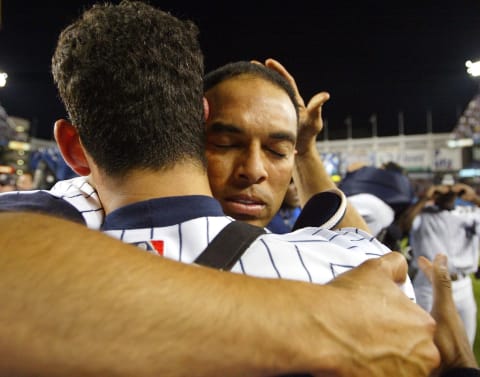
Aaron Frickin’ Boone
But it never came to that. Wakefield walked out in the bottom of the eleventh to face Aaron Boone. Boone had been brought in as a pinch runner; this was his first at bat of the game. And he needed only one flat pitch to send a deep drive into the left field seats, sending the Yankees to the World Series and their fans into delirium.
Red Sox fans, and players, however, went home in stunned, silent, disbelief. If you did not believe in the Curse before that game, you surely believed in it after.
It also signaled the last game Grady Little ever managed for Boston. He went off to Oakland for a bit and then faded into a ghost wandering through baseball purgatory, the mark of Milt Stock burned forever into his forehead.
Meaningful
Mariano demonstrated for all the world to see how much this game and series victory meant to the Yankees. Perhaps sensing their run really was over, and that the team with the most talent probably did not win, he collapsed on the mound in exhaustion and exhilaration.
This was a singular display from the normally stoic Panamanian, never seen before or since.
His effort and that of his team defined what it means to have the heart of a champion, to come back against high odds and a better team, and to stand victorious at the end. Even more than the championships they won, this series—this game—showed the entire baseball world why the Yankees are the Yankees.
And what it means to compete in the AL East. If you want it, you have to take it.
The Yankees went on to lose to the Marlins and a young Miguel Cabrera in six, along with future Red Sox ace Josh Beckett, but the loss did not seem to resonate. I have rarely met a Yankees fan who is more upset that they lost to the Marlins than thrilled that the Yankees beat the Sawx. Some don’t even know more games were played that year.
It was the most exciting series I have ever seen, and the best game seven ever played that wasn’t for the World Series title. That’s as much because it ended with an extra-inning, walk-off home run as because it was Yankees/Red Sox.
When I lied down that night in a vain effort to sleep, a smile on my lips and a song in my heart (Sweet Caroline), the universe made perfect sense.
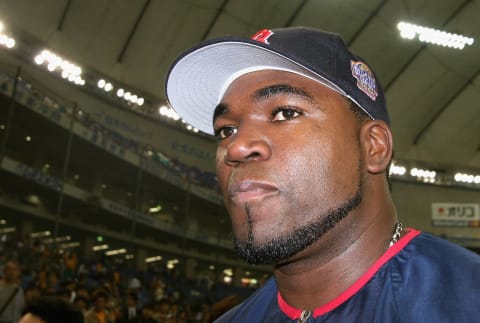
Red Sox/Yankees Vol. III
And the Red Sox? The Boys from Beantown thought they were better in 2003 than the Yankees. When that dream died riding Aaron Boone’s well-struck ball to right field, they were stunned and shocked.
Some teams fall apart after a loss like that. Not the Boys from Boston and not when you play in the Beast. Instead, they spent the winter of 2003 growing their beards, and their collective resolve.
By the time the 2004 season started, those Idiots were dumb enough to think they were better than the Yankees…and they were right.
The Yankees, meanwhile, traded for Alex Rodriguez that off-season, stealing him from the Red Sox and adding to the rivalry. It certainly seemed to steam Ben Affleck.
Both teams were now ready for what everyone who watches baseball could see coming: The Rematch. Like basketball in the mid-80’s, everyone could tell there were only two teams worth watching.
Only This Time Boston had Magic
The Yankees and Red Sox spent 2004 throwing punches at each other all season until the field was cleared and they could finally face off for seven more gut-wrenching games.
The whole season felt like that. This was the year Jeter dived into the stands, trying desperately to keep Boston at Bay, his heart on his sleeve and his blood on his face. The injuries to his face could force him from the game but never quell that man’s indomitable will to win.
Of course these two teams—these two ancient enemies who had stared at each other across the stats sheet all season, jockeying for position, wanting to have any mental edge when they met again—did, of course, meet again, for the third time in six years, in the 2004 American League Championship Series.
The description will be far briefer. If you want to hear more stories about this one, you’ll have to travel to the DR and speak with David Ortiz; I’m sure he would have plenty to say.

But they Woke to a Dream
The series started off as Boston’s worst nightmare. The Yankees won the first three games decisively. When game three was over, the score stood 19-8, and every prognosticator who could get to a TV or pick up a pen decreed the series over, and the curse continued.
But that’s how it goes with slumps and curses. If a player or a team wants to dig out of a deep hole, it always has to do so the hard way. And when that hole is almost a hundred years deep, you gotta do more than pack a lunch…you better be able to eat your opponents as midnight snacks.
Fortunately for their fans, the Red Sox players stayed hungry all night in game four.
Future Yankees player Johnny Damon showed up that next morning to take batting practice; a Moneyball shirt stretched on his frame. He wasn’t hiding any more than the rest of the Red Sox. They were angry and ready to get back at it.
They knew it wasn’t going to be easy, but, as Tom Hanks once said in A League of Their Own, the hard is what makes it good.
The Boston Red Sox take what is Theirs
And so, to win games four and five, the Sox had to go to extra innings in both. They outlasted two innings against Mariano and got to Paul Quantrill, in every sense of the phrase, in the bottom of the twelfth inning of game four.
That’s when David Ortiz lifted a home run into the stands and the spirits of everyone in Red Sox Nation.
Game five was another extra innings victory, this time taking until the bottom of the 14. The Yankees pitcher was different—Esteban Loaiza (lue-eye-za)–but the hero for the Red Sox was the same. Ortiz on this night needed only a base hit to seal the victory, driving in Damon from third.
The fans were not let down, however, as Ortiz had already blasted his big home run for the night earlier, in the bottom of the eighth inning.
That home run had sparked his team, which had entered the frame down 4-2; when the inning ended, the game was tied. But that’s who David Ortiz always was: a big hitter with clutch written all over his DNA.
Steroids probably helped him hit, but nothing can help you produce in the biggest situations. Only heart and balls can help you do that, and Ortiz had plenty of both. And he had his best years all in the AL East.
His power and presence led his team back from the brink, and the rest of the team took it from there.
It’s All About Confidence
Back for game six feeling comfortable and confident, the Red Sox needed neither Ortiz nor extra innings to beat the Yankees as the offense scored four runs in the fourth. But they did need Curt Schilling. And he needed to show the world what he was made of.
What he showed, in that series, was that he had the guts and courage to match those of Ortiz, or any player this side of Lou Gehrig. For Sox fans, Schilling had proven his mettle in game one, when he pitched after tearing his tendon.
But when he came to pitch game six after an experimental emergency procedure, he, too, rose to baseball immortality.
Curt, an adjective suited to the man, came out on the mound with stitches in his foot and determination in his heart. With blood oozing out on to his sock, his strong heart pumping it out for all the world to see what this man is made of, Schilling threw seven innings of four-hit, one-run ball. The only damage was done by the still proud and dangerous Bernie Williams.
And when Schilling walked off the mound after seven strong, the series was over.
The Red Sox came back for game seven, now sure they were better than the Yankees. They proved it quickly by scoring ten runs in the game, eight of them in the first four innings. As the Yanks only scored three that day, Boston scored the winning run in this game seven in the second inning.
The Red Sox were the better team that year. They thought they were before game six; they knew it afterward. And so they did not have to prove they were the better team in game seven, they merely had to demonstrate it.
When it was over, the Sox went on to sweep the Cardinals in the 2004 World Series and fulfill their destiny.

It Needed to be Said
Even though the Red Sox would go on to win two more titles, their accomplishments in 2004 would fill any trophy room.
First, they showed the gravitas a team must build through the off-season after a painful postseason loss. I’m sure Mets fans would have liked to see their team show this same attitude in 2016, instead of showing up for spring training with flashy cars and riding around on ponies.
You don’t break curses that way. And that 2004 team did just that, burying forever the psychological excuse of an entire region. But its weight on previous teams was real, and now it’s gone forever. That’s a herculean task, especially when you must do it against your division foe.
Remember that the Yankees were not just the best team in history, but in recent history.
And the Red Sox had to beat another kind of history: no team had ever come back from 3-0 in a best of seven baseball series. Beating the Yankees, after the beating, they took in 2003 and being down three games to none, showed more guts and courage than any team I have ever seen. And I bleed Yankees blue.
But the Red Sox did so much more by winning that series. David Ortiz, with his timely hits and demoralizing home runs, became Big Papi and an all-time Yankees nemesis. I’ve celebrated a lot of great days in Yankees history; one of them was the day That Guy retired.
A Bloody Good Victory
Curt Schilling covered himself in glory, as well, as blood covered his ankle and zeroes covered the scoreboard. Although he is linked forever to the Bloody Sock game, I doubt he owns it.
That stinky and disgusting memento probably and deservedly lies, unwashed, in the Hall of Fame alongside David Ortiz’ bat and Johnny Damon’s beard; that’s a joke, but it shouldn’t be.
This series, along with the other two played by these two foes, shows the real import of the AL East.
In those three seasons alone, the AL East was the only division to send teams to the ALCS. This happened in two other seasons, as well—2008, Rays/Red Sox and 1996, Yankees/Orioles—for an obvious total of five.
In other words, one out of every five American League Championship series over the last 25 years has featured teams only from the Beast. That makes it the unquestioned best division in the AL, for those years at a minimum. And the most dominant division in the game.
The Red Sox and Yankees did it three times. And two of the three winners went on to win that year’s World Series (Yankees in ’99, Red Sox in 2004). As mentioned way, way back some 7,000 words ago, when a team from the AL East gets to the Series, it usually wins it.
The Beast Lives
From Aaron Boone to the Bloody Sock, no two teams ever brought as much drama or created as much baseball history in consecutive seven game series as these two from the East. The last meeting meant the end of one postseason power and the beginning of another, both in the same division.
Those three match-ups drew the attention of the baseball world; the outcomes shook it to its core and reshaped the baseball landscape.
That’s what can happen when you play in the AL East.
But the loss seemed to send the Yankees into a postseason funk, one they would not break out of until 2009. In the meantime, Boston was going to win two more titles by 2016, and those teams must get their due.

2007
Boston fielded a standout team against the Colorado Rockies, but finding a standout Sox player is difficult. That’s a testament to this tight-knit team.
None of the starters, for instance, threw more than seven innings, and each pitched well enough for his team to win. But with all of that in mind, the pitching honors have to go to Josh Becket.
He pitched the most innings (7), got the most strikeouts (9), and had the lowest WHIP (1.0) of any of the starters. That his ERA (1.29) was only second lowest among starters (Lester—0.00 in 5.2 innings) tells you why this team swept the series.
It Took a Village
They were of course helped by the offense, but not overwhelmingly by one player. No, in this case, it’s the offense as a whole that tells the true story: Only two position players out of twelve failed to hit above .250.
Hard to beat a team that hits like this for six games: Future Yankees outfielder Jacoby Ellsbury.438; Mike Lowell .400; Julio Lugo .385; and, JD Drew, Jason Varitek (the old Yankees killer), and David Ortiz all hit .333.
Hitting seemed contagious as Coco Crisp only got two AB’s but still got a hit (.500), while reserve outfielder Bobby Kielty got one AB, one hit, and the highest BA any player can have (1.000).
While Lester, Beckett, Dice-K Matsuzaka, and Curt Schilling were mowing down the Rockies from the mound, the position players were raking the field.
It’s easy to see why the Sox swept Colorado in four and captured their second title in four years. 2013, however, was a bit of a surprise.
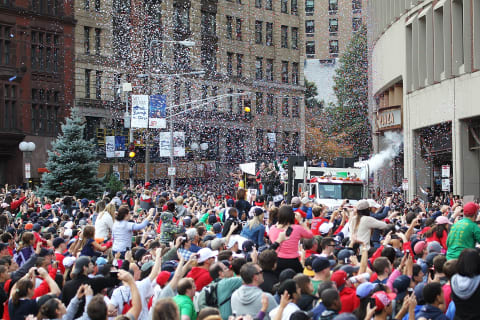
2013
Boston last won the title in 2013, beating the Cardinals and future Yankees player Matt Holliday in six games. Boston looked like a good team before the season with a real chance to win it all, although not thought of as the favorite.
But the town faced a terrorist attack during its venerable Boston Marathon, and it seemed to resonate with the team. It helped drive them all the way back to the Fall Classic. This World Series team, however, was the opposite of the previous one.
The 2007 team presented a balanced attack; only two position players out of twelve failed to hit above .250. The 2013 version was led by one man, David Ortiz, the only Boston batter to hit above .250 in this series.
Very Big Papi
And Ortiz also led with his fearsome plate presence and prodigious power. He not only slashed .688/.760/1.188, but also collected eleven hits, six RBI’s, and two home runs, all team highs.
In fact, no other Sock had more than six hits (Jacoby Ellsbury). The Sox hit only four home runs, and no one but Big Papi hit more than one.
Jon Lester, meanwhile, was the Sox best pitcher in the series. He threw the most innings (15.1) and had the best ERA of any starter with more than four innings (0.59). When the series was over, the Sox had won more titles in ten years than most clubs have won in their entire existence.
So you know they play in the AL Beast.
But we’ll finish out of order with the last Yankees World Series team, that of 2009.
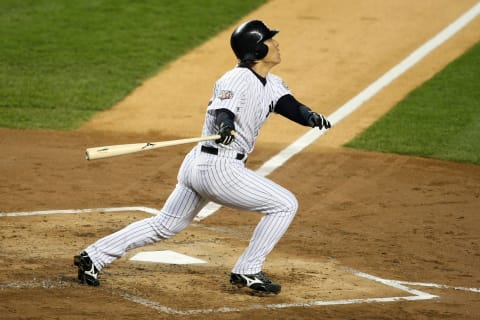
2009 Yankees
This was a strange and wonderful amalgam of a team.
For years, the players from the championship teams of the late nineties fell away and watching the Yankees subsequent seasons seemed to like seeing an Elephant slowly die on a slow, painful march to its grave.
Coney left after 2000; Tino Martinez and The Warrior, Paul O’Neill, were gone the following year. Roger “Rocket” Clemens somehow mysteriously was able to pitch well into his early 40’s, finally leaving in 2003.
And the great El Duque, Orlando Hernandez came and went, pitching his final season for the Yankees in 2004.
But after missing the playoffs in 2008, Hal Steinbrenner reloaded this team, adding youth and energy to an aged but experienced group. Back in the fold was Andy Pettitte, and he, along with newly acquired ace CC Sabathia and newly acquired enigma AJ Burnett, led the Yankees back to the World Series for the first time since 2003.
The Fightin’ Phills
There they faced the reigning World Champion Phillies. But two big factors made Yankees success seem inevitable. One, the Phillies pitching was falling apart when the playoffs began. They turned to an aging—scratch that; old—Pedro Martinez. He pitched two games in the series, including the final one, and lost them both.
And, two, the Yankees power was much better distributed. Yankees hitters blasted 244 homers that year, and the Phillies 224, but the difference between the two was much greater than that.
Ryan Howard, who looked on his way to the Hall of Fame back then, had the most of any player in the contest (45). In fact, the Phillies had four of the top five home run hitters from the two teams combined.
But there were only five players on this team with at least 18 overall. The Phils were just too top heavy. New York, meanwhile, had eight men with at least 18 dingers.
The series was a fait accompli before it began; the Yanks won in six, and the term Core Four was born. And that would be the last hurrah for the remaining dynastic players: Jeter, Pettitte, Rivera, and Posada.
As Jon Cusack said at the end of Eight Men Out, “Those guys, they’re all gone now.”
That run that ended in 2009 to the sounds of Jay Z’s, Empire State of Mind, began way back in 1996. Before we leave them forever, let’s take one last appreciative look at all they did.
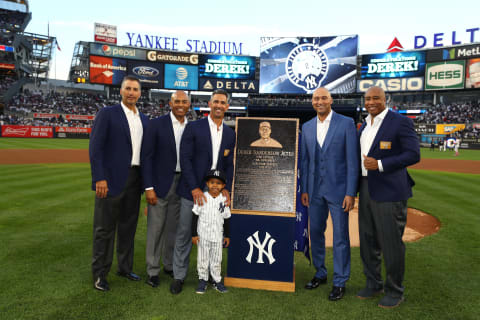
A Full Frontal Assault
The Yankee’s impact on the record books was impressive. ’98 produced the most wins of any team, when including the postseason. That team is still thought of as the best in the modern era. And the Yankees collected fourteen straight World Series wins, including two World Series sweeps.
More from Yanks Go Yard
- Twins already bailing on Gary Sánchez emphasizes Yankees’ trade failure
- New Yankees No. 2 Carlos Rodón hates Astros, dominates them
- 3 cost-effective free agents who can fill out Yankees roster after Aaron Judge deal
- Yankees sign Carlos Rodón after Scott Boras staredown to fill out special 2023 rotation
- Did wild Max Fried trade rumor give Yankees perfect fallback plan?
They were the first team in baseball to win four championships in five years since the Yankees did it in the early Fifties; before that it was the Yankees teams of the late 1930’s. Andy Pettitte became the all-time postseason wins leader, while Mo became the greatest postseason, and World Series, pitcher who ever lived.
Both David Wells and David Cone pitched perfect games during that run, while Jeter won the Rookie of the Year in 1996. And Bernie joined Paul by winning a batting title, his coming in 1998. There are too many awards and honors to mention them all here.
Safe to say that all of that ensured they would be the best team of the last 25 years. And that the AL East would be the best division. The division’s biggest claim to the title is that they have won by far the most World Series, 10.
And the Yankees won five of those.
Yes, The AL East is Supreme
The fact that they, and the Red Sox and Jays, have had so much success in the toughest division only makes the accomplishments all the more praiseworthy. This division, this American League Beast, has made its mark on baseball, and the teams that played against them. And they have the titles to prove it.
There is, perhaps, no better indication of the significance of this division than the two LCS series in the early 2000’s. Those fourteen days provided some of the biggest moments in the last quarter century (as did Joe Carter’s famous shot many years earlier). As drama dripped from every play and history was made with every series, the entire baseball world was transfixed.
Next: The Yankees Must Never Forget Barry Bonds, The Needle, and the Damage Done
Those series, filled with immortal moments, were played out by two teams from the AL East. No other match-up in baseball, perhaps in all of sports, has been as compelling in this prescribed time frame. That’s what domination means, the conquest of our imagination.
The success of this division has done just that and continues to fill us all with the hope that it continues well into the next millennium.
One thing we know for sure, though: If any other division wants the title from the Yankees and the AL Beast, they’re gonna have to take. And that ain’t easy.